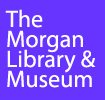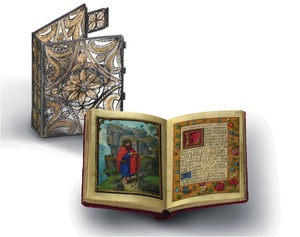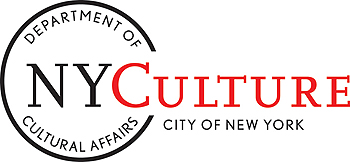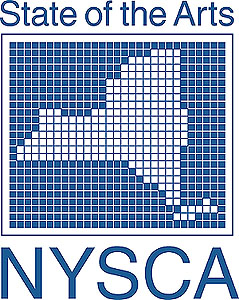| |
|
Art News:
The Morgan displays Van Damme Hours to mark facsimile publication
  |
|
THE MORGAN DISPLAYS ITS SIXTEENTH-CENTURY
VAN DAMME HOURS MANUSCRIPT ON THE OCCASION OF
ITS LONG-AWAITED FACSIMILE PUBLICATION
 New York, NY, June 5, 2013—The Morgan Library & Museum is currently displaying its sixteenth-century original Van Damme Hours to mark the occasion of the manuscript’s facsimile publication by Munich’s Faksimile Verlag. On view through October 6, 2013, the tiny (2.2 x 2.9 inch) Book of Hours is the creation of scribe Antonius van Damme and illuminator Simon Bening. New York, NY, June 5, 2013—The Morgan Library & Museum is currently displaying its sixteenth-century original Van Damme Hours to mark the occasion of the manuscript’s facsimile publication by Munich’s Faksimile Verlag. On view through October 6, 2013, the tiny (2.2 x 2.9 inch) Book of Hours is the creation of scribe Antonius van Damme and illuminator Simon Bening.
The Van Damme Hours has a storied provenance, having passed through no less than ten hands before entering the Morgan’s collection in 1924. Although the identity of the man who commissioned the work is unknown, the compelling history of the manuscript’s first known owner, John Strange (1732–1799), is well documented, as is the manuscript’s subsequent owners. Strange, a British dilettante whose eclectic interests included everything from sea sponges to Venetian paintings, supplied the manuscript with its distinctive detachable silver filigree binding. The binding is displayed alongside the manuscript at the Morgan, and replicated as part of the deluxe edition of the facsimile.
The Van Damme Hours
The Van Damme Hours (The Morgan Library & Museum, MS M.451) is named after its Flemish scribe, Antonius van Damme (active 1495–c. 1545). Although not a documented work, its superb illuminations are the work of Simon Bening (1483/84–1561), the last and greatest Flemish illuminator of the sixteenth century. The manuscript contains all of the stylistic and iconographic elements that comprise the oeuvre of Bening, including the charming illustrated calendar images in which he specialized. Van Damme and Bening had a professional, and surely also a personal, relationship for fifty years.
The book’s textual contents, which are atypical of a conventional Book of Hours, provide clues as to its original owner. Although it includes a selection of the typical texts found in Books of Hours—a Calendar, the Hours of the Virgin, the Mass of the Virgin, the Hours of the Conception of the Virgin, the Penitential Psalms and Litany, and a series of prayers and Suffrages—other traditional prayers are missing.
There are no leaves missing from the Van Damme Hours, so it is clear that these absent devotions were never intended to be included. The book must, then, have been commissioned by someone who already possessed a traditional Book of Hours, which would have contained the prayers missing from this work. Considering the paucity of Suffrages to female saints, the original owner was surely a man. The Franciscan nature of many of the texts indicates he may have been a Franciscan tertiary—a lay person who while living in the world strove for spiritual perfection under the guidance of the Third Order of St. Francis. Given the standing of the scribe and artist he hired to create the work, the original owner was no doubt quite wealthy.
The manuscript also includes “O iuste iudex Iesu Criste” a prayer that is very rare—possibly unique to this manuscript—which seems to have been composed specially for the patron.
Provenance
Upon his father’s death, John Strange became a wealthy man; his inheritance enabled him to travel and to pursue his scientific and touring interests, which frequently found him in Italy. In 1773 he was appointed Britain’s Resident at the Republic of Venice, a post he enjoyed for fifteen years, collecting and amassing his holdings of objets d’art, paintings, and books along the way. Indeed, Strange accumulated a library so vast that its sale two years after his death consisted of some 80,000 volumes and took place over a period of fifty-six days. The title page of the sale catalogue speaks to the great range of Strange’s bibliophilic collecting:
Bibliotheca Strangeiana: A Catalogue of the General, Curious, and Extensive Library of that Distinguished Naturalist and Lover of the Fine Arts, the late John Strange, Esq. LL.D…Comprehending, an extraordinary Fine Collection of Books and Tracts, in Most Languages and Sciences, to the Number of Upwards of Fourscore Thousand, in the Belles Lettres, Natural History, Mineralogy, Agriculture, Medicine, Painting and Music; in the History, Topography and Antiquities of Most Nations; but, More Particularly, in Those of Great Britain and Ireland, and the British Colonies; and in Geography, Voyages and Travels.
Despite the scope of his library, Strange owned less than two dozen manuscripts. Most were Books of Hours, which were grouped together and sold on March 19, 1801. The Van Damme Hours was purchased for a mere ₤1.8 shillings by British dealer and paintings restorer William Comyns (other Books of Hours sold better, ranging from £3 to £10).
The book remained in Comyns’ collection until it changed hands again: this time entering the collection George Spencer Churchill, fifth Duke of Marlborough (1766–1840). The Duke, a forebear of Sir Winston Churchill, ensured that the Hours would continue to change hands when his strained finances, due to extravagant expenditures on his house and gardens, forced him to sell much of his collection.
In 1900 the Van Damme Hours was on the shelves of Librairie Demascène Morgand, a bookselling business in Paris. It was from here that Louise Leboeuf de Montgermont (1841–1918), the builder of two major libraries, purchased the manuscript.
In July 1911 Edouard Rahir (1862–1924) of Librairie Demascène Morgand sold eight illuminated manuscripts from Leboeuf de Montgermont’s collection—including the Van Damme Hours—to J. Pierpont Morgan. Morgan’s librarian, Belle da Costa Greene, wrote to Rahir in July of that year, commenting, “I want to tell you that I consider all of these manuscripts of an exceptionally fine quality and that I am very pleased indeed to have you offer Mr. Morgan manuscripts of this high order.” Always a shrewd business woman, Greene continued, “I trust that you will continue to find such splendid examples for him and will never offer him anything of an inferior quality.”
Upon Pierpont Morgan’s death in 1913, the book passed into the possession of his only son, J.P. Morgan, Jr. (1867–1943). Finally, the Van Damme Hours, along with other innumerable treasures, became part of the collection of the Pierpont Morgan Library when it was created as a public institution in 1924.
Binding
It was during Strange’s years in Venice that he either commissioned or supplied the Van Damme Hours with its distinctive silver filigree binding. The manuscript’s deep navy leather doublures, decorated with fleur-de-lis and a central cross bearing Christ’s initials “JHS” (for Jesus) are also eighteenth-century Italian. Given that the first initial, being a “J” instead of the expected “I,” makes for a set of initials that match those of John Strange, it was likely he who undertook the present rebinding, trimming the manuscript to fit it within the gilt silver covers.
Facsimile
Publisher Faksimile Verlag has produced two editions of the facsimile of the Van Damme Hours. The velvet-bound deluxe edition, limited to 98 copies, includes a replica of the silver filigree binding; the leather-bound edition, limited to 882 copies, features a stamped pattern of the filigree binding.
Originally planned for the thirty-fifth anniversary of the Faksimile Verlag, the publication was delayed by several years due to technical challenges presented by the manuscript’s intricate filigree binding. After years of research, the binding has been successfully replicated by silversmiths working at Buchbinderei Burkhardt AG, Moenschaltdorf, a small artisan bookbindery in Switzerland.
Each hand-crafted facsimile is accompanied by a four-chapter commentary volume by Roger Wieck, Curator of Medieval and Renaissance Manuscripts at the Morgan.
Both editions are available in the Morgan Shop. Through October 6, 2013, the Morgan is offering both facsimile editions at the promotional prices listed below.
129 folios; 2.2 x 2.9 inches
Deluxe Edition: $4,500 (through October 6, 2013; $5,200 thereafter)
Deluxe Edition ISBN: 978-3-577-12942-8
Leather-bound Edition: $1,995 (through October 6, 2013; $2,600 thereafter)
Leather-bound Edition ISBN: 978-3-577-12909-1
© 2013 Faksimile Verlag, München
Publication date: May 2013
SPONSORSHIP
  The programs of The Morgan Library & Museum are made possible with public funds from the New York City Department of Cultural Affairs in partnership with the City Council, and by the New York State Council on the Arts with the support of Governor Andrew Cuomo and the New York State Legislature. The programs of The Morgan Library & Museum are made possible with public funds from the New York City Department of Cultural Affairs in partnership with the City Council, and by the New York State Council on the Arts with the support of Governor Andrew Cuomo and the New York State Legislature.
PRESS CONTACTS
Patrick Milliman
pmilliman@themorgan.org
212-590-0310
Alanna Schindewolf
aschindewolf@themorgan.org
212-590-0311
The Morgan Library & Museum
The Morgan Library & Museum began as the private library of financier Pierpont Morgan, one of the preeminent collectors and cultural benefactors in the United States. Today, more than a century after its founding in 1906, the Morgan serves as a museum, independent research library, musical venue, architectural landmark, and historic site. In October 2010, the Morgan completed the first-ever restoration of its original McKim building, Pierpont Morgan’s private library, and the core of the institution. In tandem with the 2006 expansion project by architect Renzo Piano, the Morgan now provides visitors unprecedented access to its world-renowned collections of drawings, literary and historical manuscripts, musical scores, medieval and Renaissance manuscripts, printed books, and ancient Near Eastern seals and tablets.
General Information
The Morgan Library & Museum
225 Madison Avenue, at 36th Street, New York, NY 10016-3405
212.685.0008
www.themorgan.org
Just a short walk from Grand Central and Penn Station
Hours
Tuesday–Thursday, 10:30 a.m. to 5 p.m.; extended Friday hours, 10:30 a.m. to 9 p.m.; Saturday, 10 a.m. to 6 p.m.; Sunday, 11 a.m. to 6 p.m.; closed Mondays, Thanksgiving Day, Christmas Day, and New Year’s Day. The Morgan closes at 4 p.m. on Christmas Eve and New Year’s Eve.
Admission
$18 for adults; $12 for students, seniors (65 and over), and children (13–16); free to Members and children 12 and under accompanied by an adult. Admission is free on Fridays from 7 to 9 p.m. Admission is not required to visit the Morgan Shop.
Image:
The velvet-bound deluxe edition, limited to 98 copies, includes a replica of the manuscript’s distinctive silver filigree binding. Image courtesy Faksimile Verlag |
The Morgan Library & Museum
225 Madison Avenue
New York, 10016
US
Read the VerticalResponse marketing policy.
|

|

| |

#
|
| YOUR FIRST STOP FOR ART ONLINE! |
|
Discover over 150,000 works of contemporary art. Search by medium, subject matter, price and theme... research over 200,000 works by over 22,000 masters in the indepth art history section. Browse through new Art Blogs. Use our advanced artwork search interface.
Call for Artists, Premiere Portfolio sign-up for your Free Portfolio or create an Artist Portfolio today and sell your art at the marketplace for contemporary Art! Start a Gallery Site to exclusively showcase your gallery. Keep track of contemporary art with your free MYabsolutearts account.
|
|
Copyright 1995-2013. World Wide Arts Resources Corporation. All rights reserved
|
|
|
